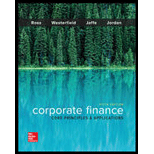
To discuss: The aspect measured by liquidity and the tradeoff faced by the firm between high and low liquidity levels.
Introduction:
The liquidity of an asset refers to its ease and quickness in converting itself into cash without any significant loss in value. Cash in hand, cash at bank, short-term investments, accounts receivable, and inventories are some of the examples of liquid assets displayed in the decreasing order of liquidity.
Explanation of Solution
Liquidity measures the following:
The liquidity measures the ease in converting an asset into cash without losing a significant portion of its value. Liquidity is very important for a firm. If a firm has a high liquidity, then it has a less risk of facing financial distress because the firm can easily convert its assets to pay off creditors.
The tradeoff faced by the firm:
Although, a higher liquidity is essential to a firm, it is not always favorable. The firm has to face a tradeoff between the high and low liquidity levels. If a firm holds excess cash in hand or bank, it would have a higher liquidity. However, this strategy is not favorable because the idle cash does not yield any return.
Similarly, if a firm invests all or most of the money in operating activities or investments, it will generate huge returns. However, this strategy will decrease the liquidity, and the firm might face financial distress. Hence, the firm has to maintain a tradeoff or balance between the liquidity levels. It cannot maintain too high or too low liquidity levels.
The liquidity measures the ease in converting the asset into cash without any significant loss in value. Very low liquidity levels will increase the risk of financial distress and very high liquidity levels will not yield any return on the cash. Hence, the firm has to face a tradeoff between the liquidity levels that it needs to maintain.
Want to see more full solutions like this?
Chapter 2 Solutions
Corporate Finance: Core Principles and Applications (Mcgraw-hill Education Series in Finance, Insurance, and Real Estate)
- No Chatgpt 2. Which of the following is a short-term source of finance? a) Bondsb) Equity sharesc) Trade creditd) Debenturesarrow_forward2. Which of the following is a short-term source of finance? a) Bondsb) Equity sharesc) Trade creditd) Debenturesno aiarrow_forward2. Which of the following is a short-term source of finance? a) Bondsb) Equity sharesc) Trade creditd) Debenturesarrow_forward
- Which of the following best describes the concept of leverage in finance? A) Using borrowed funds to increase the potential return on investment B) Reducing risk by diversifying assets C) A method to avoid paying taxes D) Increasing the company’s profit margin no aiarrow_forwardWhat does a ledger account represent? A) A detailed record of all business transactionsB) A summary of trial balancesC) An individual record for each accountD) The final balance of a financial statementarrow_forwardWhich of the following is a capital budgeting technique used to evaluate an investment project? A) Net Present Value (NPV) B) Return on Assets (ROA) C) Price-to-Earnings Ratio (P/E) D) Dividend Yield No aiarrow_forward
- What does the term 'liquidity' refer to in finance? A) The ability to quickly convert an asset into cash B) The total value of a company’s assets C) The volatility of a market D) The difference between liabilities and assets no aiarrow_forwardWhich of the following is a characteristic of a high-risk investment? A) Low returns B) Stable performance C) Potential for high returns with greater uncertainty D) Guaranteed returnsarrow_forwardWhat does the term 'liquidity' refer to in finance? A) The ability to quickly convert an asset into cash B) The total value of a company’s assets C) The volatility of a market D) The difference between liabilities and assets need help.arrow_forward
- I need help in this question now! What does a company’s price-to-earnings (P/E) ratio indicate? A) The return on investment for shareholders B) The company’s profitability relative to its stock price C) The company’s debt relative to its equity D) The company’s dividend payout ratioarrow_forwardI need answer quickly What does a company’s price-to-earnings (P/E) ratio indicate? A) The return on investment for shareholders B) The company’s profitability relative to its stock price C) The company’s debt relative to its equity D) The company’s dividend payout ratioarrow_forwardThe term 'beta' in stock market analysis measures: A) The total value of a company’s stocks B) A stock’s sensitivity to the overall market C) The dividend yield of a stock D) A stock’s price-to-earnings ratio i need help in this question!arrow_forward
 Essentials Of InvestmentsFinanceISBN:9781260013924Author:Bodie, Zvi, Kane, Alex, MARCUS, Alan J.Publisher:Mcgraw-hill Education,
Essentials Of InvestmentsFinanceISBN:9781260013924Author:Bodie, Zvi, Kane, Alex, MARCUS, Alan J.Publisher:Mcgraw-hill Education,

 Foundations Of FinanceFinanceISBN:9780134897264Author:KEOWN, Arthur J., Martin, John D., PETTY, J. WilliamPublisher:Pearson,
Foundations Of FinanceFinanceISBN:9780134897264Author:KEOWN, Arthur J., Martin, John D., PETTY, J. WilliamPublisher:Pearson, Fundamentals of Financial Management (MindTap Cou...FinanceISBN:9781337395250Author:Eugene F. Brigham, Joel F. HoustonPublisher:Cengage Learning
Fundamentals of Financial Management (MindTap Cou...FinanceISBN:9781337395250Author:Eugene F. Brigham, Joel F. HoustonPublisher:Cengage Learning Corporate Finance (The Mcgraw-hill/Irwin Series i...FinanceISBN:9780077861759Author:Stephen A. Ross Franco Modigliani Professor of Financial Economics Professor, Randolph W Westerfield Robert R. Dockson Deans Chair in Bus. Admin., Jeffrey Jaffe, Bradford D Jordan ProfessorPublisher:McGraw-Hill Education
Corporate Finance (The Mcgraw-hill/Irwin Series i...FinanceISBN:9780077861759Author:Stephen A. Ross Franco Modigliani Professor of Financial Economics Professor, Randolph W Westerfield Robert R. Dockson Deans Chair in Bus. Admin., Jeffrey Jaffe, Bradford D Jordan ProfessorPublisher:McGraw-Hill Education





